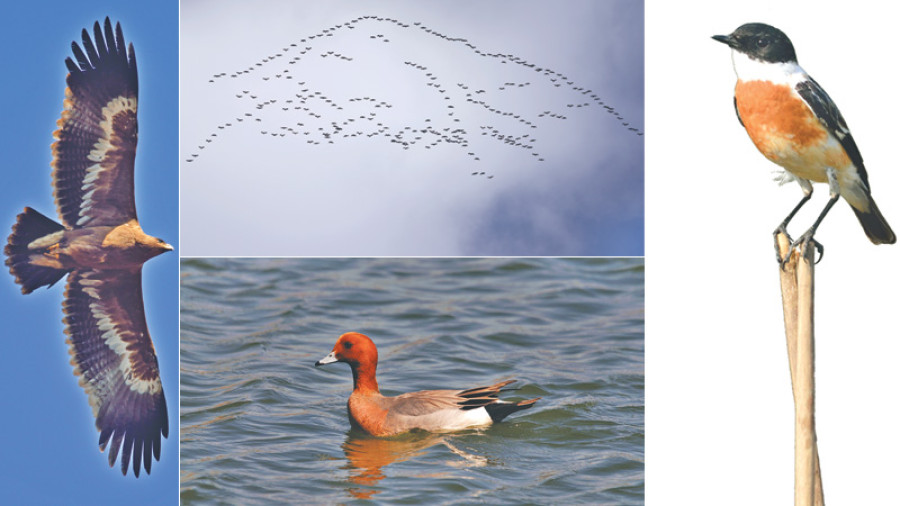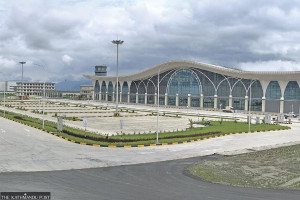Miscellaneous
Paradise lost
On the morning of September 27, 2016, Jyotendra Jyu Thakuri, senior programme officer at Bird Conservation Nepal (BCN), and his team of birders
Pragati Shahi
On the morning of September 27, 2016, Jyotendra Jyu Thakuri, senior programme officer at Bird Conservation Nepal (BCN), and his team of birders captured a few glimpses of flocks of Demoiselle Cranes (Grus virgo) passing over Samar village in Upper Mustang, at an elevation of around 3600 meters above sea level.
These delicate small crane species, locally known as Karyangkurung—after the sound they make, were undertaking a perilous journey over the Himalayas, travelling thousands of miles away from their summer home as far as Siberia, to flee the onset of the harsh winter. The migration of cranes, and some other 150 migratory bird species, through the river valleys also indicate the arrival of winter.
Every year, starting the last week of September to the end of October, large flocks of cranes pass through the Himalayas, with most travelling further south to India and as far as South Africa to escape cold northern winters. Some of these passerine birds winter in a few places in the Tarai and stay until the spring, before returning back to their original habitats for breeding.
“The arrival of cranes was delayed by over a week this year due to the erratic and extended monsoon,” says Thakuri, who has returned from his visit to the Kali Gandaki River Valley where his team were carrying out a population count of cranes this year.
The main river valleys, including Kali Gandaki, have been considered a significant route for several species including the massive flocks of Demoiselle Cranes; while Raptor species, namely Black Kite (Milvus migrans), Common Buzzard (Buteo buteo), and Lesser Kestrel (Falco naumanni) migrate in smaller numbers. “Until three to four years ago, Demoiselle cranes used Kali Gandaki Valley as a stopover and were recorded around Jomsom and Marpha. But the disturbance along the migratory routes from development works like construction of roads and expansion of settlements have impacted the movement,” said Thakuri. During the one-month count done between September and October this year, the team recorded around 15,000 cranes in Upper Mustang.
The favorable climate ranging from tropical to arctic, coupled with diverse topography, makes Nepal a favorite spot for both resident and migratory bird species. It serves as a stopover point for migratory birds flying down from Siberia, Mongolia and Tibet in September, and while the birds return to their breeding grounds in April. There are some really adventurous bird species that migrate from Europe, Africa and Southeast Asia and use Nepal as a transit.
Nepal is home to 878 bird species, around eight percent of the total known global bird population, and out of which 150 species winter in the country. Besides the cranes, various bird species like ducks, geese, waders, pipits, wagtails, thrushes, Phyllosocopus warblers, bush warblers, finches and buntings are among the other passerines found wintering in different parts of Nepal, either to use it for transit, stopover, feeding or breeding purposes.
Over the years, an increasing number of bird species around the world are under threat from the loss in biodiversity, mostly due to human-induced activities and Nepal is no exception. A first-ever assessment of the national conservation status of Nepal’s birds, prepared earlier this year, found that out of total 878 bird species recorded in Nepal, 167 species are facing severe threats due to problems ranging from habitat loss and degradation due to climate change. Various large birds such as birds of prey, storks and pheasants, that are found in lowland grassland, are the most threatened species, followed by wetland birds and tropical and subtropical forest birds.
“Habitat destruction because of human activities is forcing many bird species closer towards extinction,” says Hum Gurung, network and programme development manager at Bird Life International. In addition, climate change is impacting the loss in birdlife across the world, he added.
A study published in journal Science last year stated that habitat loss along the routes taken by the migratory birds from ever-expanding infrastructure development, conversion of forests into farmland and pollution, among others, are posing an increasing threat to the long-distance fliers, with most crossing severe terrains in search of food and better habitats.
“The priority is on globally and locally threatened species. There is a little attention spared for the overall birdlife,” said Thakuri, adding, “The total number of birds is declining overall. Though some species of birds have seen rise in population in some specific areas, the birdlife is under severe threat.”




 14.12°C Kathmandu
14.12°C Kathmandu










